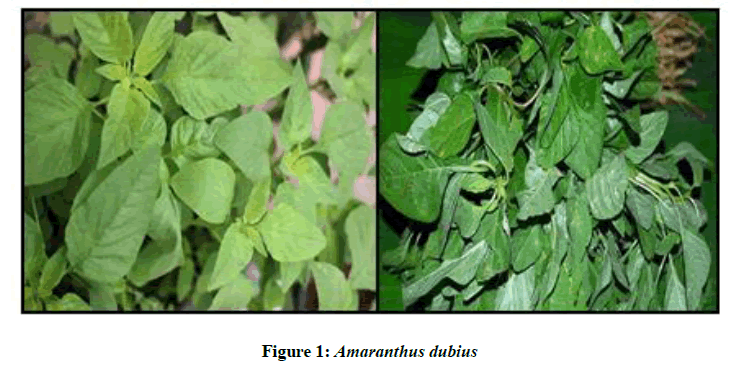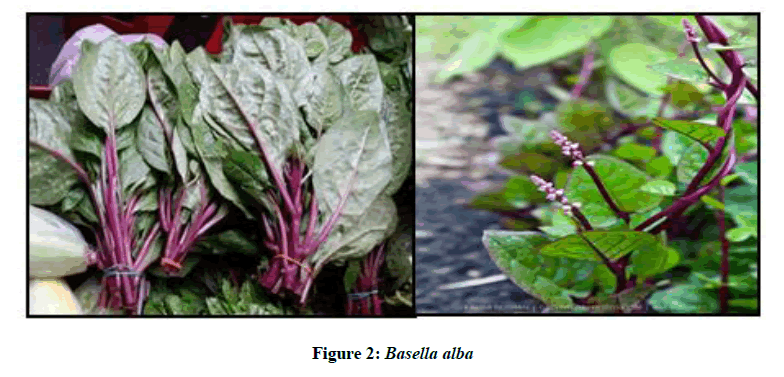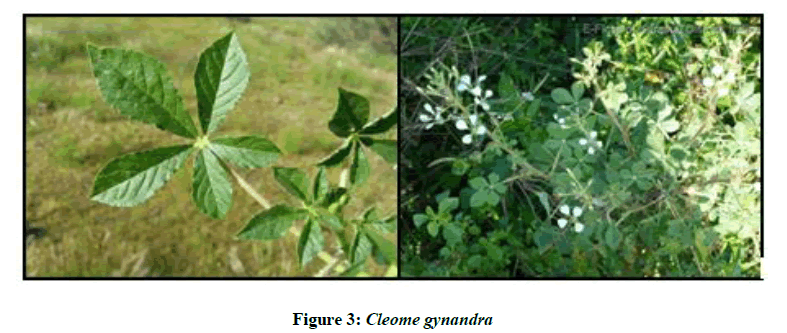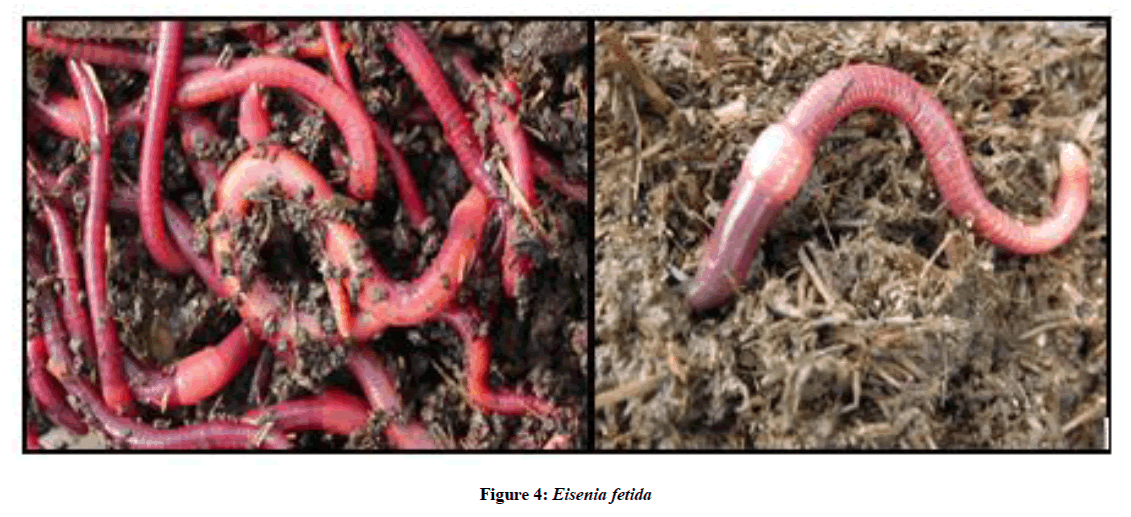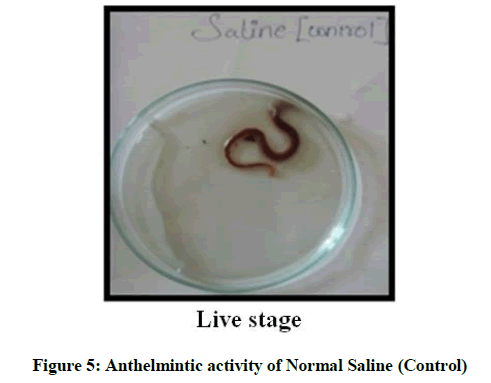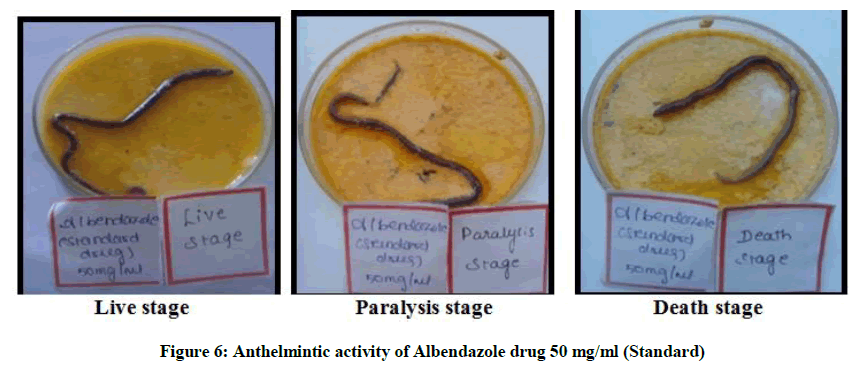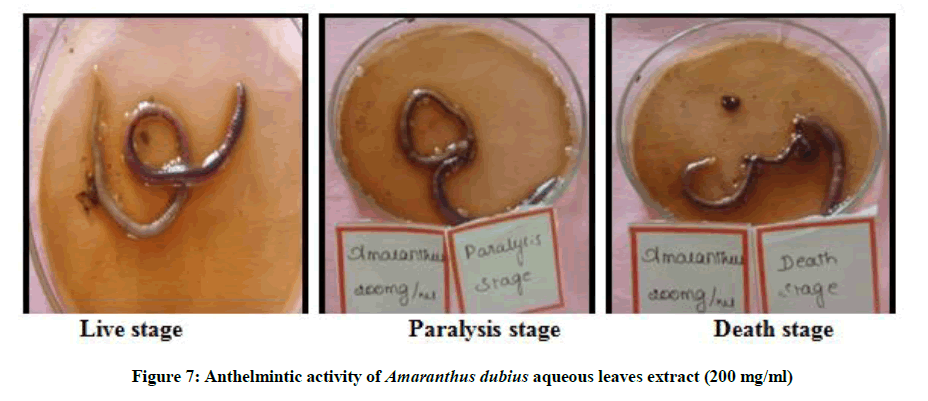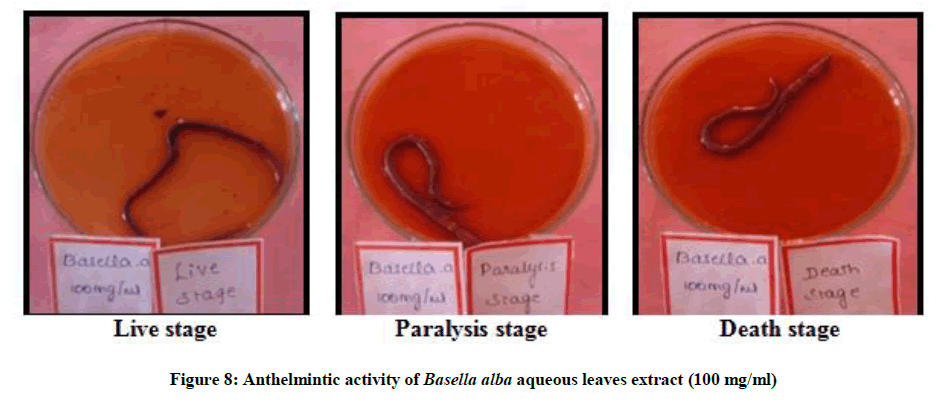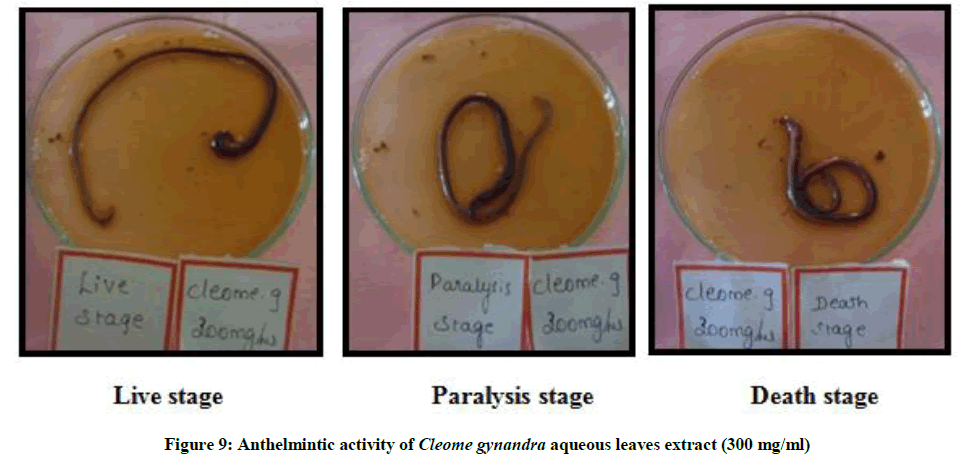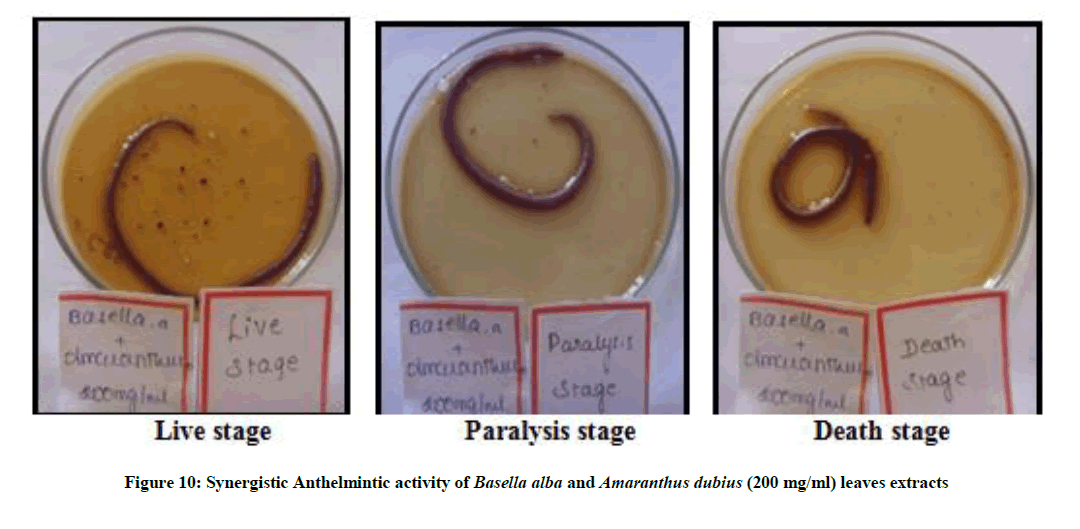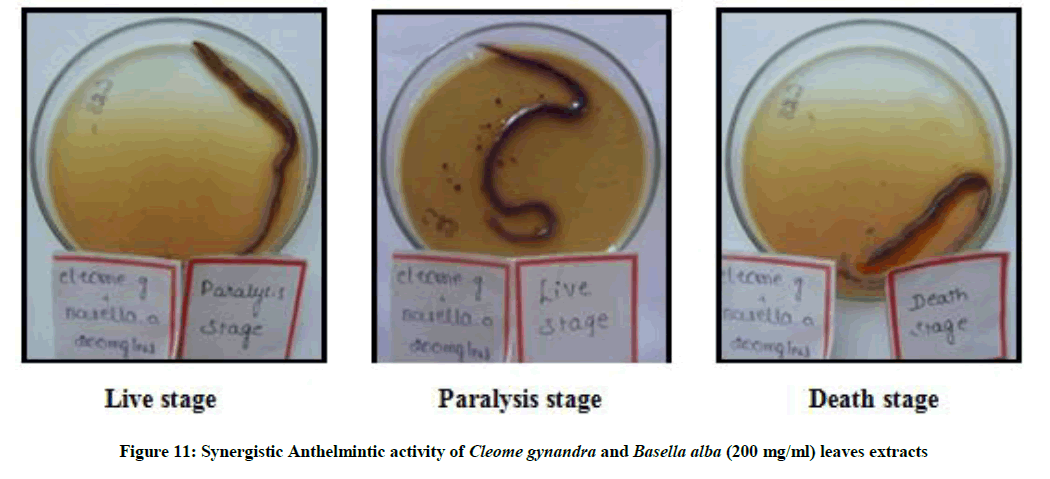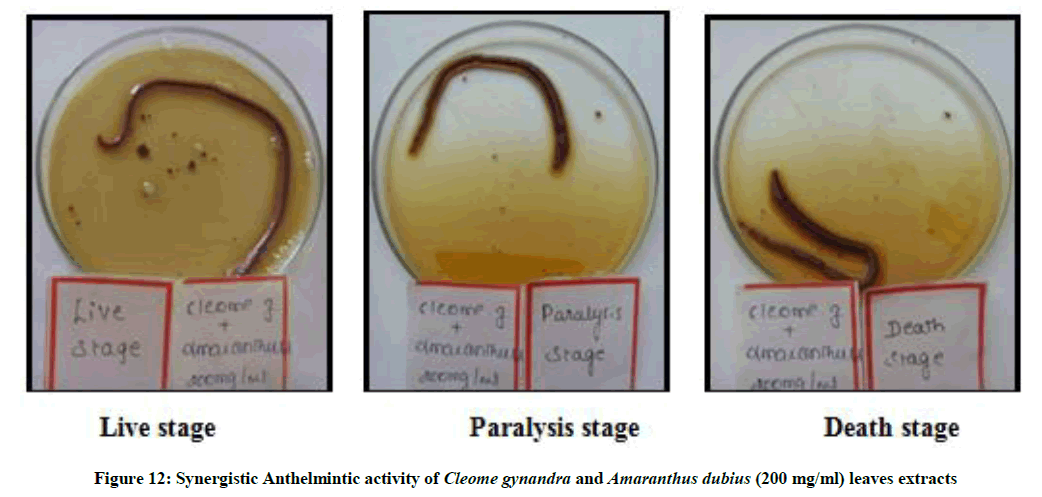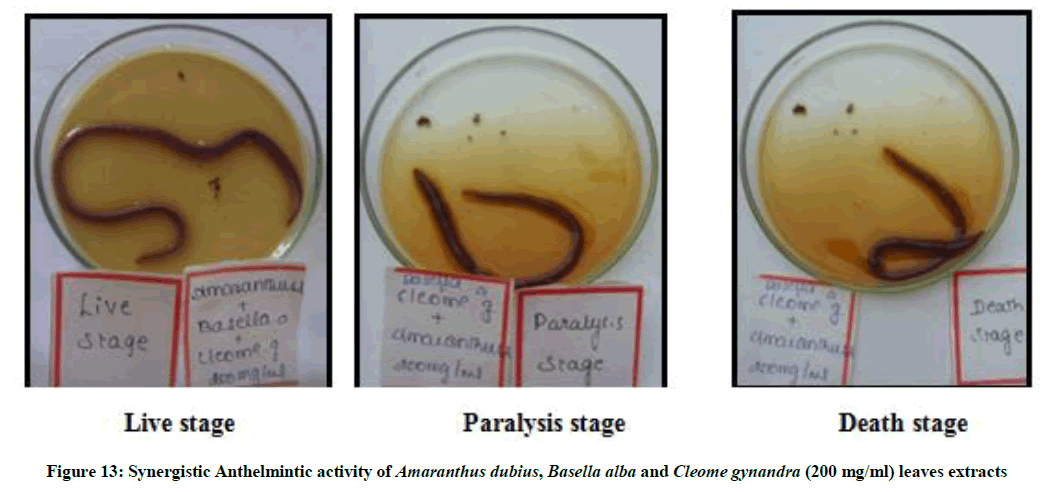Research Article - Der Pharma Chemica ( 2018) Volume 10, Issue 6
In vitro Anthelmintic Efficacy of Amaranthus dubius, Basella alba and Cleome gynandra
George B and Kousalya P*
Department of Biochemistry, Bharathidasan College of Arts and Science, Erode, Tamilnadu, India
- *Corresponding Author:
- Kousalya P
Department of Biochemistry
Bharathidasan College of Arts and Science
Erode, Tamilnadu, India
Abstract
The aim of this study was to investigate the anthelmintic activity of leaves of Amaranthus dubius, Basella alba and Cleome gynandra against adult Indian earthworm Eisenia fetida. E. fetida was selected as a model for anthelmintic activity due to its anatomical and physiological resemblance with the intestinal round worm parasites of human beings. Normal saline was used as the control while Albendazole drug at 25 mg/ml and 50 mg/ml were used as the standard drug. Three concentrations of leaves extract (100 mg/ml, 200 mg/ml and 300 mg/ml) of A. dubius, B. alba and C. gynandra were used to study the Anthelmintic activity. The 300 mg/ml proved to be very active by paralyzing and killing the earthworms in a shorter time. At 300 mg/ml A. dubius showed 18 min for paralysis stage and 28 min for death stage of E. fetida. Synergistic studies of the plants against Helminths were also carried out where two plants were combined and all had the same concentration (200 mg/ml). B. alba and A. dubius combination showed best Anthelmintic activity, paralysis stage of E. fetida at 31 min and death at stage 36 min.
Keywords
Anthelmintic, Amaranthus dubius, Basella alba, Cleome gynandra, paralysis.
Introduction
A parasitic infection including Helminthiasis is a serious problem which affects more than two billions of people worldwide. Helminths produce serious problem in human and other animals around the world [1]. Different type of helminths infects the human and animals out of which intestinal round worms (Ascardia sp.) are most common [2]. Variety of clinical symptoms arises due to this infection include dysentery, diarrhoea, nausea-vomiting, loss of appetite and weight, acidity and sometimes anaemia [2].
Anthelmintics act either locally to expel worms from the gastrointestinal tract or systemically to eradicate adult helminths or developmental forms that invade organs or tissues. Currently used synthetic anthelmintics such as benzimidazoles, piperazine, Diethylcarbamazine citrate, Ivermectin, Levamisole, etc., shows adverse effects including anorexia, nausea, vomiting, dizziness, diarrhea, occasional fever, rashes [3].
Anthelmintic plants are used traditionally in expelling the worms that are parasitic in nature from the body either by stunning or killing them. They are also known as vermifuges or vermicides. Anthelmintic medicinal plants are used as good alternatives for the traditional allopathic medicinal agents. It was found that extracts of leaves of a variety of medicinal plants shows anthelmintic properties when compared to other parts of the medicinal plant [4]. Present study was carried out to evaluate the Anthelmintic activity of leaves of Amaranthus dubius, Basella alba and Cleome gynandra against adult Indian earthworm Eisenia fetida.
Materials and Methods
Collection of plant materials
Amaranthus dubius
A. dubius (Figure 1) also known as ‘Araikeerai’ in Tamil language was collected from Erode district vegetable market, Tamil Nadu, India. The leaves were washed with water, then surface sterilized with 10% sodium hypochloride solution, rinsed with sterile distilled water and air dried at room temperature. The dried leaves were powdered and used as a raw material and stored in air tight container.
Basella alba
B. alba (Figure 2) also known as ‘Kodippasali’ in Tamil language was collected from Erode region, Tamil Nadu, India. The leaves were washed with water, then surface sterilized with 10% sodium hypochloride solution, rinsed with sterile distilled water and air dried at room temperature. The dried leaves were powdered and used as a raw material and stored in air tight container.
Cleome gynandra
C. gynandra (Figure 3) also known as ‘Nalvelai’ in Tamil language was collected from Erode district region, Tamil Nadu, India. The collected plant specimens were not cultivated but were rather occurring as a weed. On collection, the plants were in their mature stage since the pods were fully developed and some had already dispersed some seeds.
The leaves were washed with water, then surface sterilized with 10% sodium hypochloride solution, rinsed with sterile distilled water and air dried at room temperature. The dried leaves were powdered and used as a raw material and stored in air tight container.
Adult Indian earthworms (Eisenia fetida)
The adult Indian earthworms (Figure 4) were collected from the vermicomposting site of Bharathi dasan College of Arts and Science, Erode, Tamil Nadu, India. Adult earthworms of approximately 4 cm length and 0.2-0.3 cm width were used for this experiment. This organism was selected as a model for anthelmintic activity due to its anatomical and physiological resemblance with the intestinal roundworm parasites of human beings [5]. Before initiation of the experiment the earthworms were washed in normal saline.
Anthelmintic test of aqueous plant extracts of Amaranthus dubius, Basella alba and Cleome gynandra
The anthelmintic assay was carried out as per the standard method with minor modifications [6]. Test samples of A. dubius, B. alba and C. gynandra’s aqueous extracts were prepared at the concentrations (100, 200, 300 mg/ml) in distilled water by adding the dry plant powder into various amounts of distilled water and boiled for 10 minutes. The mixture was filtered and the collected supernatant was utilized for the anthelmintic tests. Adult Indian 14 earth worms (E. fetida) of approximately equal size were placed each in a nine cm Petri dish containing 20 ml of leaves extracts. Albendazole in two concentrations (25 mg/ml and 50 mg/ml) was used as reference standard and Normal saline water as the control. All the test solutions and standard drug solutions were prepared freshly before starting the experiments. Observations were made; the time taken for paralysis was noted when no movement of any sort could be observed except when the worms were shaken vigorously. Time for death of worms were recorded after ascertaining that worms neither moved when shaken vigorously nor when dipped in warm water (50°C).
Results and Discussion
Anthelmintic activity of the aqueous leaf extracts of Amaranthus dubius, Basella alba and Cleome gynadra
Table 1 and Figures 5-9 showed the anthelmintic activity of the aqueous leaf extracts of A. dubius, B. alba and Cleome gynadra. Normal saline was used as the control while Albendazole drug at two different concentrations (25 mg/ml and 50 mg/ml) were used as the standard drug. Three concentrations of the leaves extract (100 mg/ml, 200 mg/ml and 300 mg/ml) were used to study the anthelmintic activity. At 100 mg/ml concentration A. dubius leaves extract treated earth worms had taken less time for paralysis at 60 min and death of earth worms at 80 min and at the same concentration C. gynandra leaves extract showed to be least potent, time of Paralysis of earth worms was found to be 180 min and time of death of earth worms was found to be 280 min.
| S. No. | Treatment | Concentration (mg/ml) | Time in minutes | |
|---|---|---|---|---|
| Paralysis | Death | |||
| 1 | Control (Normal saline) | - | - | - |
| 2 | Standard (Albendazole) | 25 mg/ml | 21 | 31 |
| 50 mg/ml | 17 | 29 | ||
| 3 | Amaranthus dubius | 100 mg/ml | 60 | 80 |
| 200 mg/ml | 40 | 65 | ||
| 300 mg/ml | 18 | 28 | ||
| 4 | Basellaalba | 100 mg/ml | 165 | 205 |
| 200 mg/ml | 18 | 35 | ||
| 300 mg/ml | 10 | 32 | ||
| 5 | Cleome gynandra | 100 mg/ml | 180 | 280 |
| 200 mg/ml | 105 | 210 | ||
| 300 mg/ml | 51 | 120 | ||
Table 1: Anthelmintic activity of aqueous leaf extract of Amaranthus dubius, Basella alba and Cleome gynandra
At 200 mg/ml concentration B. alba leaves extract proved to be more potent by recording time of paralysis of earth worms at 18 minutes and time of death of earthworms at 28 min, while C. gynandra leaves extract proved to be the least potent, time of paralysis of earth worms at 105 min and time of death of earth worms at 210 min.
At 300 mg/ml concentration B. alba leaves extract recorded the least time taken for paralysis of earth worms at 10 min and time of death of earth worms at 32 min and at the same concentration C. gynandra leaves extract recorded the most time taken for paralysis of earth worms at 51 min and death of earth worms at 120 min.
Observations from the anthelmintic studies showed that 100 mg/ml, 200 mg/ml and 300 mg/ml concentrations of leaves extract of A. dubius, B. alba and C. gynandra caused paralysis followed by death. In 100 mg/ml concentration of leaves extract the body of the organism swelled up and becomes firm. 200 mg/ml concentration of leaves extract resulted in the peeling off skin of earth worms, blood smears were present and the body of the organism was swelled up. All the extracts caused minimized movement to the organism, a swelling on the head portion of the organism and the body became firm and swelled up on death stage. At 300 mg/ml inactivation of the organism started from the tail portion, the tail portion became paler and thinner as time went on and only the head portion had any movement. On death stage the body of the organisms had shrank compared to the live stage.
Synergistic Anthelmintic activity of Amaranthus dubius, Basella alba and Cleome gynandra leaves extracts
Table 2 and Figures 10-13 showed the Anthelmintic activity of the synergism of the leaf extracts of A. dubius, B. alba and C. gynandra in the following formulations: B. alba and A. dubius, C. gynandra and A. dubius, B. alba and C. gynandra, Basella alba, A. dubius and C. gynandra. All the combinations had 200 mg/ml concentration.
| S. No. | Treatment | Concentration (mg/ml) | Time in minutes | |
|---|---|---|---|---|
| Paralysis of earthworms | Death of earthworms | |||
| 1 | B. alba + A. dubius | 200 mg/ml | 31 | 36 |
| 2 | C. gynandra + A. dubius | 200 mg/ml | 60 | 110 |
| 3 | B. alba + C. gynandra | 200 mg/ml | 55 | 145 |
| 4 | B. alba + C. gynandra + A. dubius | 200 mg/ml | 60 | 120 |
Table 2: Anthelmintic activity of Synergistic aqueous leaves extract of Amaranthus dubius, Basellaalba and Cleome gynandra
The B. alba and A. dubius recorded the least time for Paralysis of earthworms at 31 min and death of earthworms at 36 min. The C. gynandra and A. dubius combination recorded the most time taken for paralysis of earthworms at 60 min and death of earthworms at 110 min. Mixture of all the leaf extracts, B. alba, A. dubius and C. gynandra recorded the time of Paralysis of earthworms at 60 min and time of death of earthworms at 120 min.
Summary and Conclusion
Anthelmintic activity of the Aqueous extracts of the plant samples were tested against Adult Indian earthworms (E. fetida). Normal saline was used as the control and Albendazole drug (25 mg/ml and 50 mg/ml) was used as the standard. Anthelmintic activity was studied using three concentrations of the plant extracts (100 mg/ml, 200 mg/ml and 300 mg/ml). The 300 mg/ml proved to be very active by paralysing and killing the earthworms in a shorter time. A. dubius showed best anthelmintic activity at 300 mg/ml concentration against earthworms (18 min for paralysis stage and 28 min for death stage). Among the three plants C. gynandra was the least potent.
Synergistic studies of the plants against Helminths were also carried out where two plants were combined and all had the same concentration (200 mg/ml). B. alba and A. dubius combination showed best Anthelmintic activity against earthworms (31 min for paralysis stage and 36 minutes for death stage).
References
- E. Hossain, G. Chandra, A.P. Nandy, S.C. Mandal, J.K. Gupta, Parasitol. Res., 2012, 110, 809-814.
- K.D. Tripathi, Essentials of Medical Pharmacology, Jaypee Brothers Medical Publishers (P) Ltd, New Delhi, 6th (Edn.), 2008, 808-810.
- J.G. Gilman, J.G. Hardman, L.E. Limbird, The Pharmacological basis of therapeutics, McGraw-Hill Medical Publishing division, United states of America, 10th (Edn.), 2001, 450-455.
- V. Prakash, B.N. Mehrotra, Ind. J. History Sci., 1987, 22, 4, 332-40.
- Z. Vigar, Atlas of Medical Parasitology. In, P.G. Publishing House, Singapore, 1984, 2nd (Edn.), 216-217.
- P. Udaya Sri ,V. Leelavathi , N. Vijaya Sree , M. Anil kumar , IOSR J. Pharm. Biol. Sci., 2015, 10, 6, 61-65.

